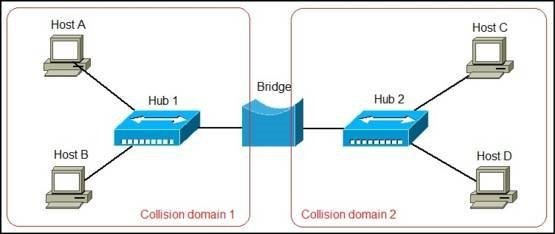A bridge is a type of computer network device that provides interconnection with other bridge networks that use the same protocol.
Bridge devices work at the data link layer of the Open System Interconnect (OSI) model, connecting two different networks together and providing communication between them. Bridges are similar to repeaters and hubs in that they broadcast data to every node. However, bridges maintain the media access control (MAC) address table as soon as they discover new segments, so subsequent transmissions are sent to only to the desired recipient.
A network bridge is a device that divides a network into segments. Each segment represent a separate collision domain, so the number of collisions on the network is reduced. Each collision domain has its own separate bandwidth, so a bridge also improves the network performance.
A bridge is also called Layer 2 Switch. A network bridge is a device that is primarily used in Local Area Networks (LANs). It is because these networks can potentially flood and clog a large network.
It is one of their abilities that they broadcast data to all the nodes if they do not know the destination node’s address. The bridge uses a database.
The purpose of this database is to ascertain where to pass the data frame, where to transmit the data frame, or where to discard the data frame. Network bridges are also called Ethernet bridges. They connect two segments of a single network together. The main purpose of bridges is to divide a network into different manageable sections.
A bridge works at the Data link layer (Layer 2) of the OSI model. It inspects incoming traffic and decide whether to forward it or filter it. Each incoming Ethernet frame is inspected for destination MAC address. If the bridge determines that the destination host is on another segment of the network, it forwards the frame to that segment.
Consider the following example network:

In the picture above we have a network of four computers. The network is divided into segments by a bridge. Each segment is a separate collision domain with its own bandwidth. Let’s say that Host A wants to communicate with Host C. Host A will send the frame with the Host C’s destination MAC address to the bridge. The bridge will inspect the frame and forward it to the segment of the network Host C is on.
Network bridges offer substantial improvements over network hubs, but they are not widely used anymore in modern LANs. Switches are commonly used instead.
Types of bridges in networking
Following are some Types of bridges in networking
-
Transparent Bridge
This is a bridge in which the stations are completely unaware of the experience of the bridge. For example, May or May not a bridge is added or deleted from the network, the station’s reconfiguration is unnecessary. This bridge makes use of two different processes like bridge forwarding and bridge learning.
-
Source routing bridge
In this bridge, the routing operation is performed by the source station. The frame specifies which route to follow. The hot discovers the frame by sending a special frame which is called a discovery frame. This spreads through the entire network by using all possible paths to the destination.
Advantages of bridges
- Bridges can extend a network.
- Bridges can act as a repeater.
- They can reduce network traffic on a segment.
- They can subdivide the network communication.
- They increase the available bandwidth to individual nodes.
- Bridges reduce collisions as well.
- Bridges can create separate collision domains.
- They can connect different architectures.
Disadvantages of bridges
- They are slower than repeaters.
- Filtering makes them slower.
- They do not filter broadcasts.
- Bridges are more expensive.
- They must use routable protocols.
- They need to understand the protocols which they forward.
- They require a lot of amount for initial configuration.
- These are complex devices.
- These devices are unable to read a specific IP address.
- Its speed is slow.
- Bridges cannot use a firewall as a device.
- They send messages to all the nodes.
- Sending a message to all nodes reduces speed.
- Sending messages to all nodes causes a waste of time.
One thought on “Bridges”